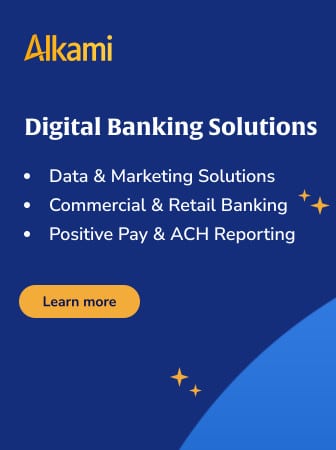The popularity and promise of open banking have spawned myths and misconceptions about this technology. Some banking institutions expect them to be universal problem-solvers or accelerants that can lead to instant growth and revenue gains.
Such misconceptions can be more than misleading — they can be dangerous. They can lead institutions with limited tech resources or tech budgets down paths that bring little return on investment, don’t align with overall tech strategy, or don’t add value for their account holders.
Banking institutions best-positioned to succeed will be those able to make strategic decisions free of the many myths that exist about open banking’s use cases and potential.
Here are three of the most common misconceptions that community banks should avoid as they explore how to deploy open application programming interfaces (APIs) within their tech strategies.

The unfair advantage for financial brands.
Offering aggressive financial marketing strategies custom-built for leaders looking to redefine industry norms and establish market dominance.

Creating A Community with CQRC’s Branch Redesign
Find out how SLD helped CQRC Bank to create the perfect harmony of financial services, local culture, and the human touch in their branch transformation.
Read More about Creating A Community with CQRC’s Branch Redesign
Myth 1: Open Banking is Just for Big Banks
Open banking has become trendy. Community banks can feel intimidated and overwhelmed by it. Many reach the conclusion that it’s too much to tackle.
Busting the myth: With hot-button issues like embedded finance, embedded fintech and payments-as-a-service dominating conversations about the future, community banks might not even realize that they’re likely already embracing the most important idea behind open banking: third-party integrations.
Third-party integrations are the most fundamental category of open banking tech. Fortunately, they are also the one any community bank can leverage within their tech stacks in the form of APIs.
The beauty and value of open banking don’t rest on the sweeping technological changes that revolutionize a bank’s entire operations and growth potential. They rest in a bank’s ability to explore applications and technologies at a pace they’re comfortable with.
• For a few, it might mean an end-to-end tech modernization initiative.
• For most, it comes in the form of incremental investments in a specific area of the tech stack that align with the broader growth strategy.
Many of the most important open banking use cases are those the customer never sees but every back office needs — areas like loan decisioning, underwriting, payments processing, exception tracking, document management and account opening.
Read more: Trends 2024: Consumers Will Drive Open Banking, Not Regulators
Myth 2: Banking-as-a-Service is the Best Use Case for Community Banks
“Fear Of Missing Out” among community banks really exists. They see news of others deploying open banking technologies and want the perceived revenue figures that result from becoming a sponsor bank and absorbing a fintech’s customer base as a cost-efficient means of growth.
But you have to walk before you can fly. Pursuing status as a sponsor bank in a banking as a service model without preparation amounts to trying to land on the moon without yet inventing the rocket.
“FOMO” has created a market-sized space race that overlooks the critical investment in infrastructure required for banks to achieve a goal as lofty as a fintech partnership. It also overlooks just how risky a proposition bank-fintech partnership can be for community banks. Many may not immediately realize the compliance and data-ownership risks that accompany an influx of huge numbers of new customers. [Dig Deeper: How FinWise Bank Plans to Survive the Storm in Banking as a Service]
Busting the myth: There are many other open banking use cases that are more valuable to a community bank’s existing growth strategy than BaaS and require fewer resources and less risk.
It’s for that reason that many community banks choose to focus on high-value, low-risk, API-based initiatives like real-time integrations for account opening. They provide clear tech upgrades that integrate easily with any core. They open or grow valuable lines of business like deposit accounts or mortgage loans without a complete overhaul. And they can improve back-office operations as well as front-end customer experience.
Starting small encourages community banks to focus on an area they’re already good at or one they need to improve to grow. Fear and uncertainty drive too many decisions about tech investments. This can limit the current initiative’s success and leave bank decision-makers unwilling to adopt a piece of technology they actually need in the future. They will reason: “It didn’t work last time.”
Asking the right questions is often all banks need to do to mitigate that risk: What problem are we trying to solve for our customers? What target markets align with our strategy and goals? Do we have the right technology to take advantage of integrations? How do we ensure we remain compliant?
Answering these types of questions through a strategic mindset will not only help banks avoid the wrong decision, they can also guide long-term approaches to growth through adoption.
Growth can come in many forms — an online account opening initiative in a branchless market, a new card or payments program for non-traditional customers, or a data-driven cross-marketing campaign that personalizes products for every account holder.
The common denominator is always a strategy rooted in purpose rather than fear.
Read more: How CFPB 1033 Charts the Future of Open Banking

Myth 3: Open Banking Applications Require Tech Geniuses
Adopting an API-driven tech strategy shouldn’t require additional IT resources and staff.
Busting the myth: In fact, the subject matter experts in the line of business for which an API is being integrated are the ones best equipped to maximize its value, and should be involved in any strategic discussion about tech adoption.
An account specialist in loans or deposits already knows what data the institution needs and how and where they need it. That’s almost always enough. When it isn’t, the supporting documentation provided through the developer portal around an API is built for non-developers, like loan account specialists, to easily read and understand.
Open banking has taken on a life of its own in financial services in recent years, leaving community banks wondering if, where and how it fits into their ability to grow.
It can be easy to dismiss as unattainable or, conversely, to chase the most revolutionary use case on the market. The reality is somewhere in the middle.
Open banking can add tangible, long-lasting value for community banks who invest in it the right way, which includes avoiding the many misperceptions about its potential and capabilities.
About the Author
Shanda Purcell is the senior director of open banking at CSI. She works with customers, vendors and product teams to develop and integrate a robust catalog of APIs that connect CSI’s solutions to a broad range of fintech and financial services applications.







